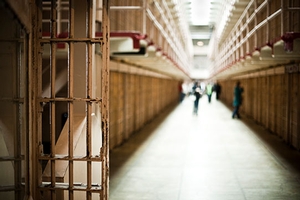Research
Understanding How the Prison Population Rises as Crime Falls

The AU School of Public Affairs' Political Theory Institute kicked off its spring semester lecture series recently with a presentation by John Pfaff, professor of law at Fordham University in New York and author of "Locked In: The True Causes of Mass Incarceration and How to Achieve Real Reform."
After years of maintaining a stable prison population in the United States, the number of people in incarcerated in state or federal facilities rose from about 200,000 in 1970 to 1.56 million in 2014. Another 700,000 are held in county jails. Although the United States is home to only 5 percent of the world's population, it houses 25 percent of its prisoners.
Pfaff explained how politics, guard unions, and the expansion of prosecutors in rural and suburban areas are contributing to a growing prison population, even when crime rates are declining. Tougher sentencing laws are sending more people to prison, and county budgets are hiring more prosecutors who have huge advantages over public defenders because prosecutors have more resources. They also are elected, and the notion of being tough on crime resonates with those who are more likely to vote, are affluent, and have little understanding of the cost of prison on society. Too many Americans, Pfaff says, hold the simplistic notion that filling prisons will stop crime.
"It doesn't matter which way crime moves," said Pfaff. "Prison isn't the way to fight it. Prisons are inefficient."
Sending people to prison initially incapacitates them, but it eventually leads to so much more recidivism that incarceration results in a net loss that worsens labor market outcomes and strengthens dependence on public assistance. Incarceration also exacts a huge social cost: Incarceration is linked with physical abuse, risk of drug overdose after release, significant loss of income, and family disruption.
Pfaff suggests support for reform will come as the result of talking about what works. He advocates approaches such as better community policing, more drug treatment, improved job opportunities, and effective social programs. Prison reform is complicated because there is no coherent system. Instead, it is a patchwork of county, state, and federal facilities governed by a variety of entities with overlapping budgets. Because only 16 percent of inmates are jailed for drug offenses, he says, reforms must address violent offenders. Pfaff acknowledges there are no easy fixes, but he hopes his book will advance the conversation about solutions. "It's not an issue of imagination," he says. "It's an issue of being willing."
Elisabeth Holmes (Law & Society/Philosophy '20) says she attended the lecture with hopes of turning what she learned into a term paper this semester. "He [Pfaff] totally said the opposite of what I thought were the main issues of incarceration" she said. "It was incredibly interesting to hear about all the costs of prison, and I appreciate how he based everything on clear statistics. It expanded my world view on prisons. I definitely want to learn more."

